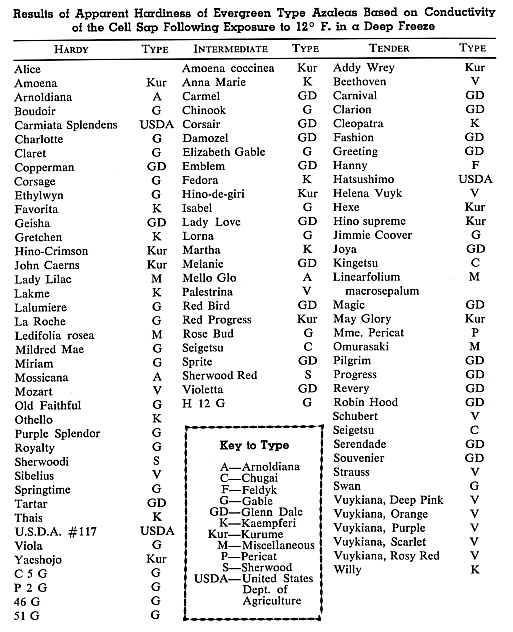Azaleas Hardiness Studies
By Robert L. Ticknor and Paul F. Bobula
University of Massachusetts, Waltham, Mass.
Cont. No. 1177 of the University of Massachusetts
College of Agriculture Experiment Station, Amherst, Mass.
Testing of the evergreen type of azaleas for hardiness has been underway at the Waltham Field Station since 1951. In the spring of 1951, 114 varieties of azaleas including Arnoldiana, Chugai, Gable, Glenn Dale, Kaempferi, and U. S. D. A. hybrids were set out. All of these three-year-old plants as well as some three-year-old plants of azalea and rhododendron species normally hardy at Waltham were killed by frost on November 7, 1951. A check on weather conditions revealed that October had been a month of high rainfall following a dry period. Late growth which is promoted by this weather pattern had occurred in this and other years when injury was noted.
Because weather conditions causing injury do not occur every year, work with a laboratory method of hardiness testing was initiated in 1954. Estimation of relative hardiness by the conductivity of the cell sap has been used in alfalfa, apples, peaches, and roses. This is an electrical measurement of the salts which diffuse from plant cells ruptured by freezing. The greater the injury, the more salts diffuse, and a higher reading is obtained on the meter.
Azaleas to be tested are grown in a greenhouse at 50° F. night temperature. During the dormant period, November, December, and January, one and two year old branches are removed from the plants and are placed in plastic bags. These bags are placed in a deep freeze where the temperatures are lowered 20 F per hour till a temperature of 12° F. is reached. While 26° F. will produce serious splitting of the bark out-of-doors, a much lower temperature seems necessary to separate the hardy and tender varieties by this method. At 14° F. very little measurable injury occurs, while at 10° F, all varieties are injured.
The twigs, after freezing are cut into small sections and the pieces are soaked in distilled water. The conductance reading, to estimate the relative hardiness, is taken on the water extract.
Our results obtained by the conductivity method are presented in Table 1. These results concur quite closely with field observations at Waltham. We would appreciate hearing of your findings as to the relative hardiness of these azaleas.

|
Blanket statements as to the relative hardiness of the various hybrid groups do not appear to be valid. However, more of the Gable hybrids have proved hardy with us than the Glenn Dales or Kurumes. Some of the Gable hybrids most satisfactory for us, 'Boudoir', 'Charlotte', 'Claret', 'LaRoche', 'Old Faithful', 'Purple Splendor', 'Royalty', 'Viola', 46G, and 51G seem to have inherited some of the lavender coloration of
Rhododendron yedoense poukhanense
. This species, except for color, is about the most satisfactory semi-evergreen azalea for this area.
'Hino-de-giri' is probably the most popular variety in sales in this area, although it is hardy only in protected locations. We are hoping to find an azalea which is as red as 'Hino-de-giri', but which would be hardy under average conditions in this area. If anyone knows of plants red or of other colors which they feel would be hardy in New England, we would appreciate hearing of them so we may test them if they are available.
Conductivity testing for hardiness, because the equipment is expensive, will probably never be used by home gardeners or commercial growers. It would be extremely useful in screening the large number of azaleas and rhododendrons already available or in conjunction with a breeding program if it is established that the hardiness estimates are generally accurate for a wide area.